Understanding Patient Transport Equipment for Professional Settings
When searching for gurney or stretcher options, you need to know the core differences that impact your daily operations:
Quick Answer:
- Stretcher = Manual carrying device, requires 2+ operators, portable and collapsible
- Gurney = Wheeled stretcher with adjustable height, operated by 1 person, includes side rails and hydraulics
- Key Difference = Gurneys have wheels and advanced features; stretchers are basic carrying platforms
- Cost Range = Stretchers: $200-$1,000 | Gurneys: $1,000-$5,000
The choice between these transport devices affects everything from staff safety to operational costs. Back injuries account for up to 50% of all EMS worker injuries, with improper lifting of stretchers being a leading cause. Modern powered gurneys can reduce physical strain on caregivers by up to 80% compared to manual stretchers.
Both devices trace back centuries - stretchers appeared in 14th-century manuscripts as simple wicker frames, while the modern gurney evolved from Sir Goldsworthy Gurney's innovations in the 1800s. Today's versions include hydraulic lifts, powered wheels, and specialized features for different transport needs.
As Mortuary Cooler, I've spent years helping funeral homes and medical facilities select the right transport equipment for their specific needs. My experience with gurney or stretcher selection has shown that understanding these key differences is crucial for making smart purchasing decisions that improve both safety and efficiency.
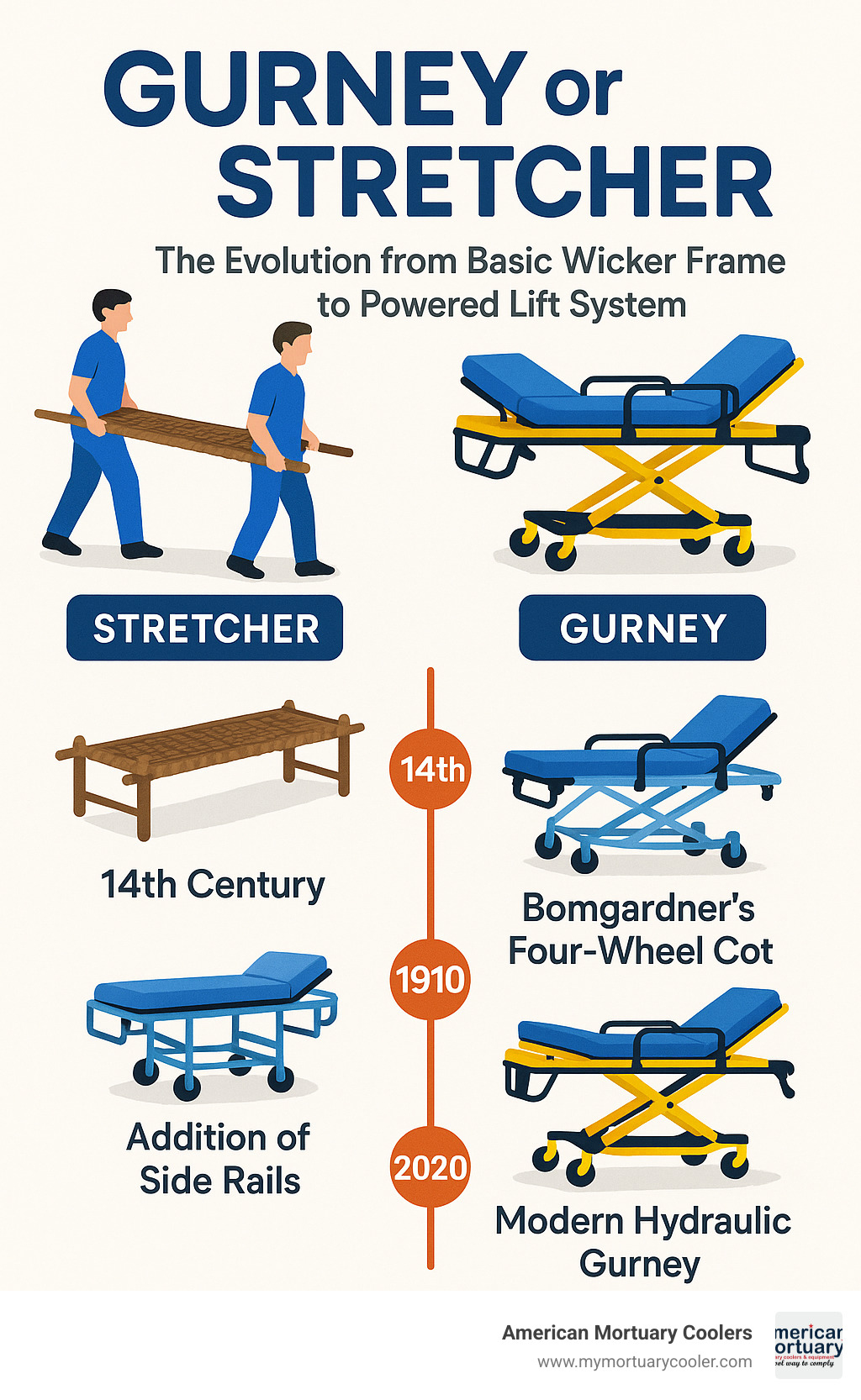
Essential gurney or stretcher terms:
Gurney or Stretcher: Definitions & Origins
The story of patient transport equipment is fascinating when you dig into it. Picture this: back in 1380, French soldiers were being carried on simple wicker frames - basically the great-great-grandparents of today's sophisticated transport devices. These early stretchers were about as basic as you could get, requiring multiple people to lift and carry wounded soldiers off battlefields.
Fast forward to 1910, and we see the real game-changer. Bomgardner developed the first four-wheel stretcher using steel tubing with spring-mounted canvas. This wasn't just an improvement - it was revolutionary. For the first time, you could roll a patient instead of carrying them. By 1920, someone had the brilliant idea to add side rails to keep unconscious patients from rolling off during transport.
Now, here's where things get interesting with the whole "gurney or stretcher" naming situation. The term "gurney" has a bit of mystery around it. While Scientific research on historic cots points to Sir Goldsworthy Gurney (1793-1875) as a possible namesake, the connection isn't crystal clear. This guy invented theatrical limelight and other mechanical devices, but whether he directly inspired the gurney name is still debated among medical historians.
What we do know is that hospitals started using "gurney" to describe their fancier wheeled stretchers, while "stretcher" stuck around for the simpler, manual-carry versions. It's like how we call some vehicles "cars" and others "trucks" - they both transport things, but they're built for different jobs.
What is a Stretcher?
Think of a stretcher as the Swiss Army knife of patient transport - simple, reliable, and ready for action anywhere. These devices are all about portability over fancy features. A basic stretcher consists of canvas or synthetic material stretched over a lightweight frame, usually aluminum or steel, weighing under 50 pounds.
The beauty of stretchers lies in their collapsible design. They fold up for easy storage and can go places where wheels just won't work. More info about stretcher types shows how battlefield medics, wilderness rescue teams, and emergency responders rely on these workhorses when navigating tight spaces or rough terrain.
Manual operation is both a feature and a limitation - you'll need two or more people to safely carry a patient. But this also means stretchers work in situations where gurneys simply can't go, like up narrow staircases or through dense forest.
Modern stretchers have evolved into specialized tools: folding stretchers collapse for compact storage, scoop stretchers split in half for spinal injury patients, basket stretchers provide rigid frames for helicopter rescues, and flexible stretchers work like heavy-duty tarps with handles for tight spaces.
What is a Gurney?
A gurney is what happens when you take a stretcher and give it a serious upgrade. These are the wheeled transport systems you see rolling through hospital corridors, complete with all the bells and whistles that make patient care easier and safer.
The key features that set gurneys apart include wheeled frames with swivel casters and locking mechanisms, adjustable height through hydraulic or electric systems, side rails for patient safety, and integrated accessories like IV poles and storage compartments. But here's the real game-changer: single-operator capability.
While stretchers need a team, one trained professional can safely move a patient on a gurney. This isn't just convenient - it's a huge operational advantage in busy medical facilities where staff time is precious.
Modern gurneys are designed for hospital corridors, ambulances, and medical facilities where smooth surfaces make wheeled transport practical. They often include advanced positioning features like Trendelenburg positioning (tilting the patient head-down), Fowler's position (lifting the head), and specialized mattresses for patient comfort during extended transport.
Key Features & Components That Matter
When you're choosing between a gurney or stretcher, understanding the technical details can save you thousands of dollars and prevent workplace injuries. Let me walk you through what really matters in these transport devices.
The foundation of any quality transport equipment starts with the frame. You'll find three main materials in professional-grade units. Aluminum alloy offers the best balance - it's lightweight yet incredibly strong, plus it won't rust in humid environments. Stainless steel frames provide maximum durability and are easy to sanitize, though they weigh more. Some manufacturers now use carbon fiber composites for ultra-lightweight applications, but these come with a premium price tag.
Here's where modern technology really shines: Hydraulically-equipped stretchers have revolutionized patient transport. These battery-powered systems automatically raise and lower patients, eliminating the back-breaking manual lifting that injures so many healthcare workers. Most systems adjust from 8 inches to 36 inches with the push of a button, and they include emergency manual backups when the power fails.
The wheel system makes or breaks your daily operations. Large-diameter wheels roll smoothly over door thresholds and small obstacles. Swivel casters let you steer tight corners in cramped spaces. Look for central locking mechanisms that secure all wheels simultaneously - fumbling with individual wheel locks during an emergency wastes precious time.
For facilities handling larger patients, bariatric options are essential. These reinforced units support 650 pounds or more, feature wider platforms (up to 35 inches versus the standard 24 inches), and include beefed-up hydraulic systems designed for heavier loads.
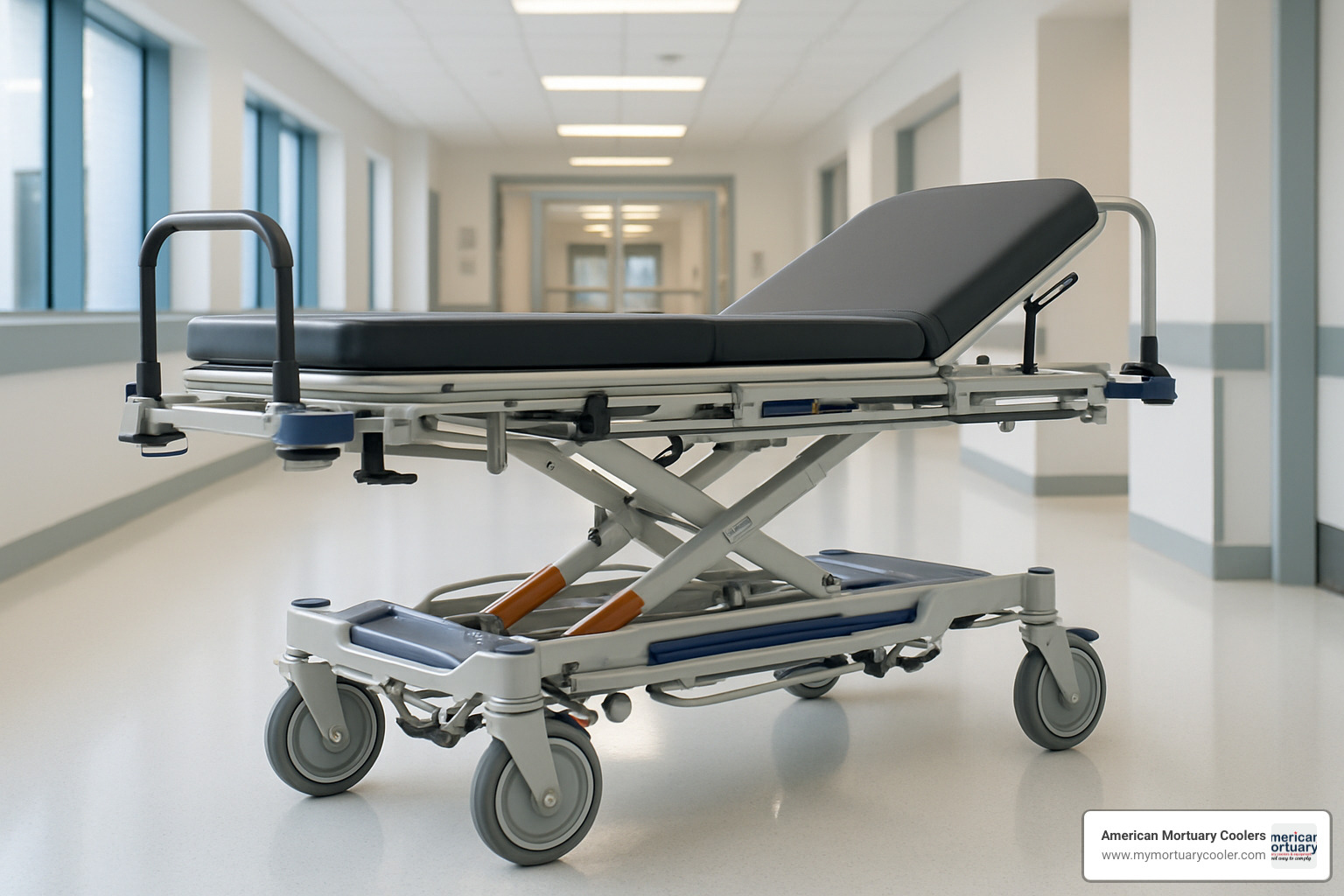
Safety & Patient Comfort
Patient safety features separate professional equipment from basic models. The best gurneys incorporate multiple safety systems that work together seamlessly.
Restraint systems need to be both secure and accessible. Look for multi-point patient straps with quick-release buckles that emergency responders can operate even while wearing gloves. Padded restraints prevent pressure injuries during longer transports, and color-coded systems help staff identify the right strap quickly.
Side rail technology has come a long way from simple metal bars. Modern rails feature quick-release mechanisms for emergency access, padding to prevent injuries during transport, and integrated controls that let patients adjust their position. The best systems include automatic locking to prevent accidental lowering.
Positioning options matter more than you might think. Trendelenburg positioning (tilting the patient head-down) is crucial for treating shock. Reverse Trendelenburg helps patients with breathing difficulties. Fowler's positioning (raised head) keeps patients comfortable during routine transports, while full-flat positioning is essential for spinal injury precautions.
Infection control features have become critical in recent years. Antimicrobial surface treatments, waterproof mattress covers, and seamless construction eliminate places where bacteria can hide. Non-porous materials throughout the unit make thorough cleaning possible between patients.
Caregiver Ergonomics
The numbers don't lie - EMS workers face injury rates that would shut down other industries. Back injuries represent up to 50% of all workplace injuries in emergency medical services, and improper patient transport equipment is often the culprit.
Single-operator capability changes everything. Instead of coordinating multiple staff members, one trained professional can safely move a patient. This cuts staffing requirements in half, eliminates the communication challenges between operators, and actually improves response times in emergency situations.
Battery-powered assistance systems use lithium-ion technology to provide 8-12 hours of operation on a single charge. These systems can automatically load patients into ambulances, provide powered wheel assistance when going uphill, and still include emergency manual override capabilities when the battery dies.
Smart ergonomic design keeps operators healthy. Handle heights are optimized for average operator stature, push and pull forces stay under 35 pounds, and smooth rolling surfaces minimize the effort needed to move patients. Clear sight lines help operators steer safely through crowded hallways.
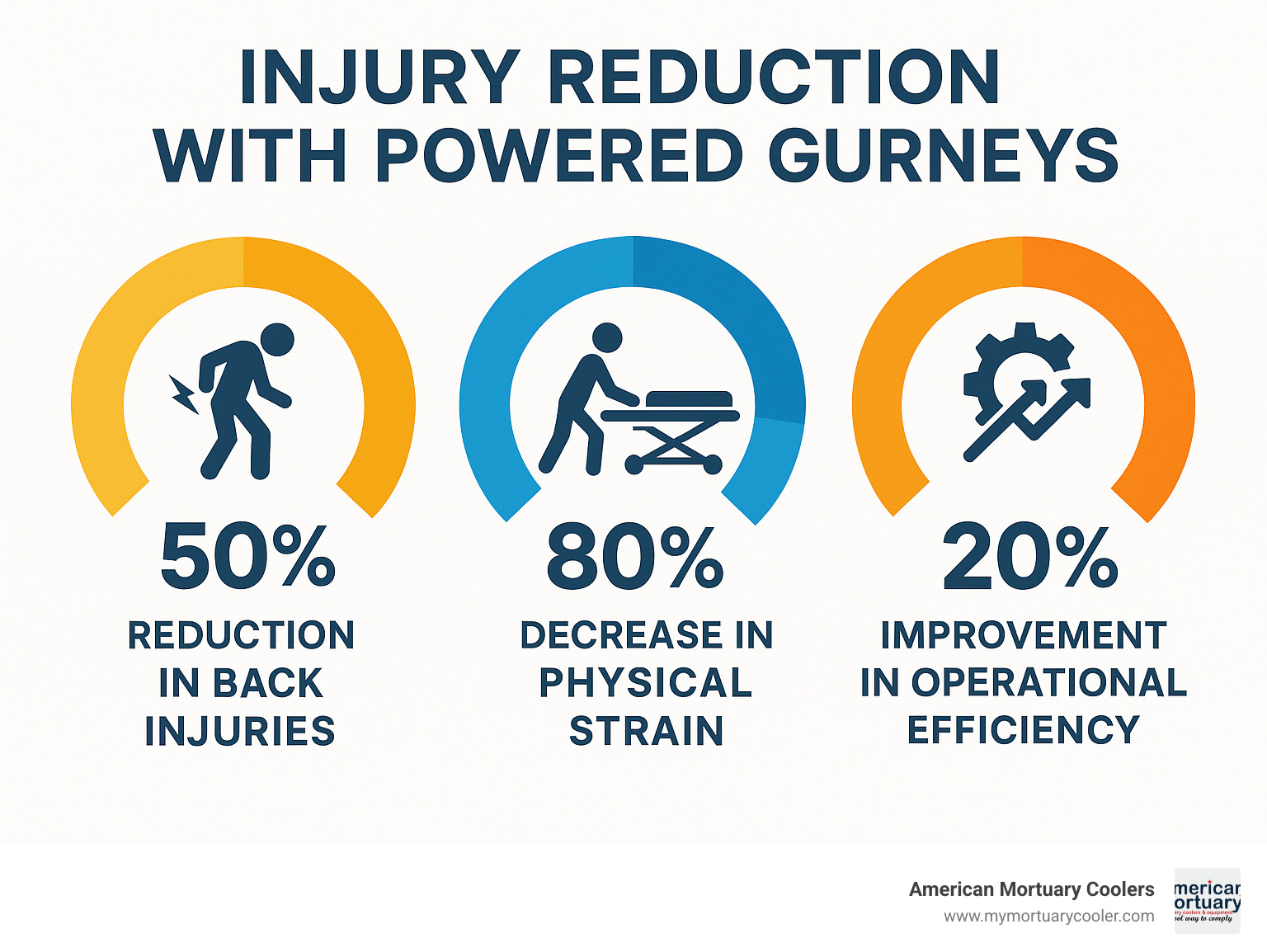
Comparison Table: Gurney vs Stretcher Components
| Feature | Basic Stretcher | Standard Gurney | Powered Gurney |
|---|---|---|---|
| Weight Capacity | 350-500 lbs | 500-650 lbs | 650-1000 lbs |
| Operators Required | 2-4 people | 1 person | 1 person |
| Height Adjustment | Fixed/Manual | Manual/Hydraulic | Powered |
| Price Range | $200-$1,000 | $1,000-$3,000 | $3,000-$5,000+ |
| Portability | Excellent | Good | Limited |
| Maintenance | Minimal | Moderate | Regular |
| Battery Life | N/A | N/A | 8-12 hours |
| Vehicle Integration | Manual loading | Latch systems | Auto-loading |
When to Use a Gurney or Stretcher in Real-World Scenarios
Choosing between a gurney or stretcher isn't just about features - it's about matching the right tool to your daily reality. After helping facilities from Johnson City, TN to Los Angeles, CA select transport equipment, I've learned that context matters more than specifications.
Emergency Medical Services face the toughest decisions because they need equipment that works everywhere. One minute you're carrying a patient down three flights of stairs, the next you're rolling smoothly through hospital corridors. Modern ambulance cots solve this puzzle by combining stretcher portability with gurney convenience - they collapse for manual carrying but roll like gurneys when you need wheels.
Hospital transfers are gurney territory, plain and simple. Those smooth floors and wide hallways were made for wheels. Plus, when you're moving patients between departments all day, the ability to adjust height for bed-to-gurney transfers becomes a back-saver for your staff.
Here's something interesting: Non-Emergency Medical Transportation providers are finding that up to 90% of their stretcher trips could actually use transport wheelchairs instead of full gurneys. That's a huge cost savings opportunity that many facilities miss.
Wilderness rescue teams live in stretcher world. When you're hiking two miles through rough terrain to reach a patient, wheels don't help much. Basket stretchers work beautifully for helicopter evacuations, while flexible stretchers squeeze through tight spaces like caves or dense forest.
For mortuary services, the choice gets more personal. Families deserve dignity during their most difficult moments, which means your transport equipment needs to look professional and operate quietly. At American Mortuary Coolers, we've designed mortuary stretchers that adjust to match embalming table heights while maintaining the discrete appearance funeral homes need. More info about EMS stretcher choice covers additional considerations for specialized transport needs.
Emergency vs Non-Emergency Transport
The clock changes everything when it comes to gurney or stretcher selection. Emergency calls demand speed and flexibility - your equipment needs to deploy fast, carry manually when stairs block the way, and load quickly into vehicles. Rapid deployment beats comfort features every time in true emergencies.
Non-emergency transport flips these priorities. Patient comfort during longer trips becomes crucial, especially for routine dialysis runs or scheduled procedures. Caregiver ergonomics matter more when staff use equipment repeatedly throughout their shifts rather than in adrenaline-fueled emergency responses.
The 30-minute rule provides a practical guideline: trips under 30 minutes can use basic stretchers effectively, while longer journeys justify gurney features like adjustable positioning and improved suspension. Trip distance directly correlates with how much patients appreciate comfort features.
Constant monitoring needs also influence equipment choice. Patients requiring continuous IV drips or cardiac monitoring benefit from gurney stability, while stable patients can travel comfortably on stretchers.
Cost & Operational Considerations
Let's talk money, because equipment decisions ultimately come down to dollars and sense. Purchase prices tell only part of the story - basic stretchers start around $200, standard gurneys run $1,000-$3,000, and powered units reach $5,000 or more.
Maintenance costs reveal the hidden expenses. A single gurney wheel replacement costs $250-$300, while hydraulic system service ranges from $500-$1,500 annually. Stretchers need minimal maintenance beyond occasional fabric replacement.
But here's the flip side: gurneys can reduce labor costs by 20% through single-operator efficiency. When you calculate staff wages saved over five years, that expensive gurney might actually cost less than cheap stretchers requiring two-person teams.
Vehicle modifications add another cost layer. Stretchers work in almost any vehicle, while gurneys often need specialized mounting systems, ramps, or hydraulic lifts. These modifications range from $2,000-$10,000 depending on complexity.
Insurance billing sometimes favors gurneys, with some providers reimbursing gurney transport at higher rates than stretcher transport. However, billing requirements vary significantly by region, so verify your local policies before making equipment decisions based on reimbursement assumptions.
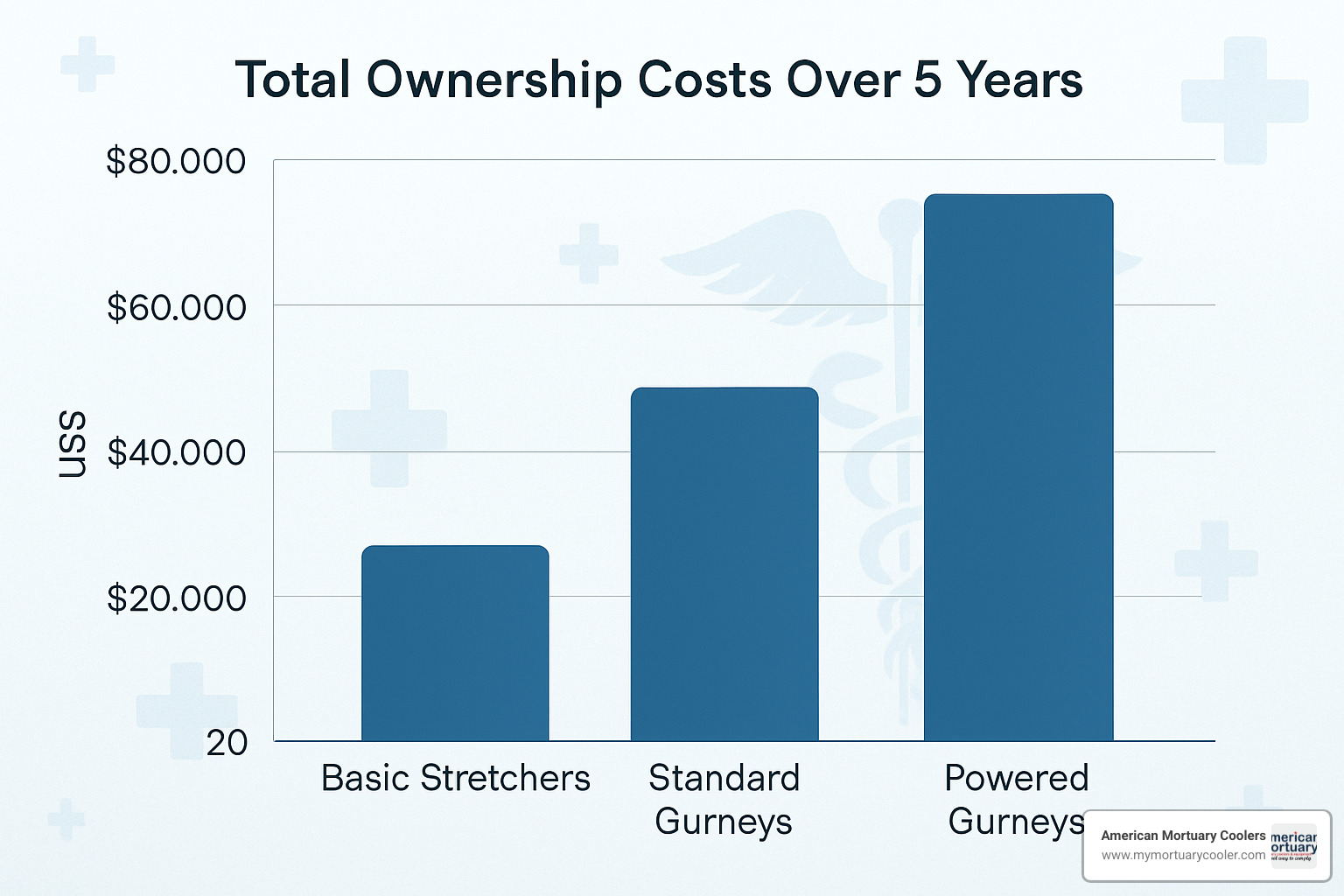
Innovations & Future Trends in Patient Transport
The gurney or stretcher field is evolving at warp speed. Powered cots now feature 5th-wheel drive to help caregivers push uphill and lithium-ion lift systems that run a full 8-12-hour shift on one charge. Some large hospitals have adopted joystick-steered, self-propelled gurneys that cut staff injuries dramatically.
Hybrid stretcher-chairs are another smart upgrade, switching from flat to seated in seconds and letting patients travel with more dignity. In the non-emergency world, crash-tested WC19 transport wheelchairs now replace the majority of stretcher trips, delivering the same safety at a fraction of the price.
Sustainability is finally part of the conversation. New antimicrobial, fully recyclable surfaces clean faster and last longer, reducing both infection risk and environmental impact.
Upcoming smart-sensor add-ons will:
- Record vital signs during the ride
- Auto-weigh patients for accurate dosing
- Warn staff if the platform tilts too far
- Trigger predictive maintenance before breakdowns
- Provide GPS tracking for fleet management
Alternatives to a Gurney or Stretcher
Sometimes the right tool isn’t a gurney or stretcher at all. Transport wheelchairs keep alert patients upright, scoop stretchers split for spinal cases, stair chairs glide down narrow steps, and rigid air-rescue baskets protect patients during helicopter lifts. More info about stretcher vs cot market dives deeper into these specialty options.
At American Mortuary Coolers we’re seeing growing demand for highly specific, environment-focused transport solutions. Patient-centered design, smarter electronics and greener materials are shaping the next generation of safe, dignified transport equipment.
Frequently Asked Questions about Gurney or Stretcher
How have gurneys and stretchers evolved historically?
The journey from medieval carrying devices to today's sophisticated transport equipment tells a remarkable story of human ingenuity. Picture this: in 1380, wounded soldiers were carried on simple wicker frames that looked more like oversized baskets than medical equipment. These early stretchers required four strong men to lift and carry - not exactly efficient during a battle!
The real breakthrough came in 1910 when Bomgardner revolutionized patient transport with his four-wheel stretcher design. Using steel tubing and spring-mounted canvas, he created the first truly gurney or stretcher hybrid that could roll instead of requiring constant lifting. By the 1920s, someone had the brilliant idea to add side rails - probably after watching too many patients slide off during bumpy rides.
The modern era brought game-changing innovations. Hydraulic systems arrived in the 1980s, finally giving caregivers' backs a break. Powered wheels followed in the 1990s, and by the 2000s, we had gurneys that could practically think for themselves with integrated electronics.
Today's equipment represents the pinnacle of this evolution. Modern gurney or stretcher designs reduce caregiver injuries by up to 80% while providing patient comfort that medieval soldiers couldn't have imagined. It's amazing how far we've come from those wicker baskets!
What safety features should I check before purchasing?
Safety isn't just a checkbox item - it's what separates professional equipment from dangerous imitations. When I help funeral homes select transport equipment, I always start with the basics that can literally save lives.
Locking mechanisms deserve your closest attention. Side rails should lock with a satisfying click and release easily during emergencies. I've seen too many accidents caused by rails that looked secure but weren't. Test every lock yourself - don't just trust the sales demonstration.
Weight capacity requires honest assessment of your needs. If your heaviest patient weighs 400 pounds, don't buy equipment rated for exactly 400 pounds. Add at least 20% safety margin because ratings can be optimistic, and you'll sleep better knowing you have extra capacity.
Restraint systems should feel comfortable yet secure. Quick-release buckles must work smoothly under pressure - fumbling with complicated straps during emergencies helps nobody. Look for padded restraints that won't cause pressure injuries during longer transports.
For hydraulic systems, verify that manual backup operation works flawlessly. Batteries die at the worst possible moments, so your equipment needs to function without power. Emergency lowering capabilities should be clearly marked and easy to operate.
Wheel systems need central locking that actually stops all movement. I've witnessed gurneys rolling away during patient transfers because one wheel didn't lock properly. Larger wheels roll more smoothly over thresholds and small obstacles, reducing jarring motions for patients.
Are powered gurneys worth the higher upfront cost?
This question hits close to home for many funeral directors and medical facility managers. The sticker shock of powered gurneys can be intimidating, but let's break down the real numbers.
Labor savings provide the clearest benefit. Converting from two-person stretcher operations to single-operator gurney use immediately cuts your staffing requirements in half. If you're paying two employees $20 per hour for transport duties, a powered gurney pays for itself through labor savings alone.
Injury prevention offers substantial but harder-to-calculate benefits. Back injury claims average $40,000-$60,000 each, not counting the disruption to your operations and staff morale. The 80% reduction in physical strain translates to fewer workers' compensation claims and improved employee retention.
Operational efficiency improves in ways you might not expect. Single-operator transport eliminates the coordination challenges of managing multiple staff members. Response times improve because you don't need to wait for a second person to become available.
However, powered gurneys aren't maintenance-free. Budget $1,500-$3,000 annually for upkeep, battery replacement, and occasional repairs. Staff training takes time, and some employees resist change initially.
The break-even calculation typically works out to 18-24 months for facilities with moderate transport volume. Low-volume operations might find better value in quality manual gurneys or stretchers. High-volume facilities often recover their investment within the first year.
At American Mortuary Coolers, we help clients evaluate their specific situations because there's no one-size-fits-all answer. The right gurney or stretcher choice depends on your volume, budget, and long-term operational goals.
Conclusion
Making the right gurney or stretcher choice can transform your daily operations from a constant struggle to a smooth, efficient process. After years of helping facilities across the country - from small funeral homes in Tennessee to major medical centers in California - I've seen how the right equipment makes all the difference.
The decision ultimately comes down to matching your specific needs with the right tool. Stretchers shine in emergency situations where you need quick deployment and portability. They're your go-to choice when navigating tight spaces, rough terrain, or situations where wheels just won't work. Plus, they're budget-friendly and require minimal maintenance.
Gurneys excel in routine transport where smooth surfaces allow their wheels to do the heavy lifting. The ability to adjust height hydraulically and operate with just one person makes them invaluable for busy facilities. Yes, they cost more upfront, but the reduction in staff injuries and improved efficiency often pays for itself within two years.
Here's what really matters when making your choice: Consider your environment first. Hospital corridors and funeral home facilities with smooth floors are perfect for gurneys. Emergency scenes and outdoor locations often require the flexibility of stretchers. Think about your staff too - powered gurneys can reduce back injuries by up to 80%, which is huge when you consider that back injuries cost facilities an average of $50,000 per claim.
At American Mortuary Coolers, we understand that funeral service professionals have unique needs. Your transport equipment needs to be not just functional, but respectful and professional-looking. Height adjustment becomes crucial when working with embalming tables, and quiet operation matters during services.
The funeral industry is evolving, and so is transport equipment. Smart sensors, sustainable materials, and improved ergonomics are making equipment safer and more efficient. But don't get caught up in bells and whistles - focus on reliability, safety, and features that actually improve your daily work.
Whether you're transporting patients in a hospital or providing dignified service in a funeral home, your equipment choice affects everyone involved. The right gurney or stretcher doesn't just move people - it protects your staff, improves patient comfort, and supports the quality care you're committed to providing.
For specialized mortuary transport needs, More info about top-rated mortuary stretchers provides detailed guidance on selecting equipment that meets the unique requirements of funeral service professionals.
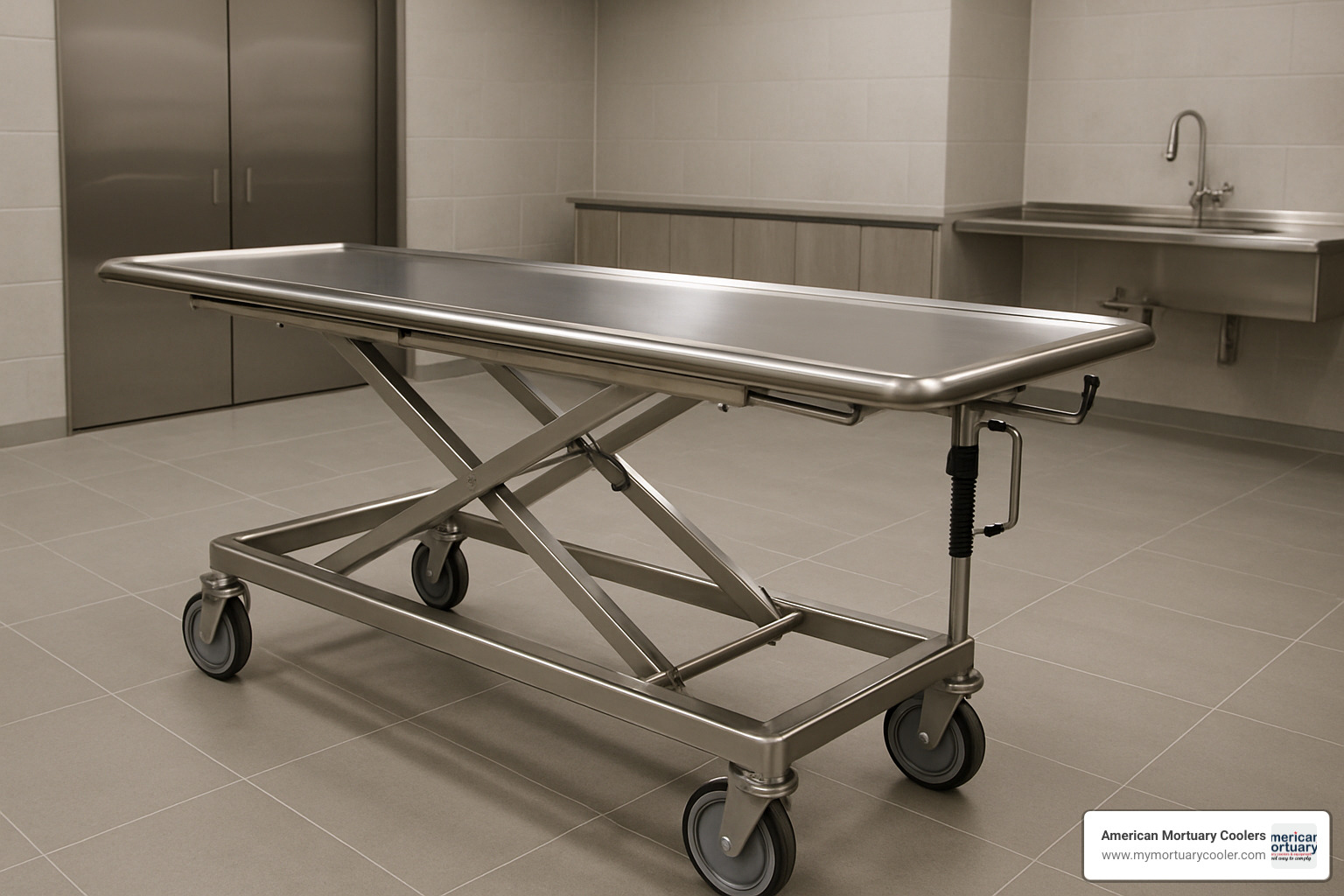
Take your time with this decision. Test equipment when possible, talk to other professionals in your field, and don't hesitate to reach out to manufacturers with questions. The right choice will serve you well for years to come and make your important work just a little bit easier every single day.